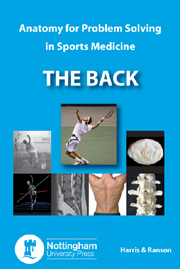Book contents
- Frontmatter
- Acknowledgements
- Foreword
- Contents
- Introduction
- Posture and Curvatures
- Vertebrae
- Spondylolysis and Spondylolisthesis
- Spinal Joints
- Anatomical Factors Influencing Spinal Nerve Compression By Intervertebral Discs
- Movements Of The Head and Spine
- Spinal Cord, Meninges and Spinal Nerves
- Muscles
- References
- Answers to Problems
- Index
Answers to Problems
- Frontmatter
- Acknowledgements
- Foreword
- Contents
- Introduction
- Posture and Curvatures
- Vertebrae
- Spondylolysis and Spondylolisthesis
- Spinal Joints
- Anatomical Factors Influencing Spinal Nerve Compression By Intervertebral Discs
- Movements Of The Head and Spine
- Spinal Cord, Meninges and Spinal Nerves
- Muscles
- References
- Answers to Problems
- Index
Summary
Problem No. 1
i) Thoracic paravertebral muscles
Thoracic joints
Intervertebral
Facet
Costo-vertebral
Costo – transverse
Thoracic Intervertebral disc
Thoracic vertebra
Thoracic nerve roots
Rib
Supraspinous, posterior longitudinal and interspinous ligaments
ii) Cumulative micro-trauma from repetitive high intensity asymmetrical stress on the structures listed above
iii) T6 or T7
iv) May predispose to bony pathology e.g. stress fracture
v) Rib stress fracture
vi) Increased mid-thoracic kyphosis and scoliosis concave to the left due to prolonged right side-flexion in a rower whose oar is on the right.
vii) Associated irritation of the adjacent thoracic sympathetic ganglion
Problem No. 2
i) Pars Interarticularis/Pedicle L3-5
Left L3-S1 facet joints
Paraspinal muscles – Quadratus lumborum and Psoas
Intervertebral disc
ii) Cumulative micro-trauma from repeated end range, high force lumbar extension coupled with left side-flexion and rotation
iii) Pars Interarticularis/Pedicle L3-5 stress fracture
Left L3-S1 facet joint injury
Intervertebral disc
iv) No pain with lumbar flexion
No pain with sitting/coughing/sneezing
Only painful with throwing
No radiating pain
No neurological symptoms
v) Pain only with throwing and extension
Pain eases with a short rest from aggravating activity but resumes soon after
vi) Pain with or without ROM limitation with lumbar extension
Positive Stork test (combined extension, side-flexion and rotation)
Tenderness over the L4 articular pillar
Negative neurological and neural tension tests
vii) Fast bowling in cricket
Pitching in baseball
Golf swing
Tennis serve
viii) MRI – to exclude acute bony stress (marrow oedema, periostitis +/− fracture line in pars interarticularis or pedicle), to exclude joint and disc pathology, to exclude ligamentous or muscular pathology
CT to stage any suspected bony lesion
- Type
- Chapter
- Information
- Anatomy for Problem Solving in Sports MedicineThe Back, pp. 61 - 66Publisher: Nottingham University PressPrint publication year: 2012



